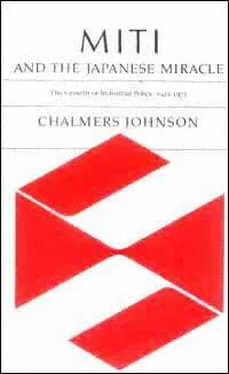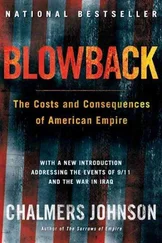Chalmers Johnson - MITI and the Japanese miracle
Здесь есть возможность читать онлайн «Chalmers Johnson - MITI and the Japanese miracle» весь текст электронной книги совершенно бесплатно (целиком полную версию без сокращений). В некоторых случаях можно слушать аудио, скачать через торрент в формате fb2 и присутствует краткое содержание. Год выпуска: 2007, Издательство: Stanford University Press, Жанр: Старинная литература, на английском языке. Описание произведения, (предисловие) а так же отзывы посетителей доступны на портале библиотеки ЛибКат.
- Название:MITI and the Japanese miracle
- Автор:
- Издательство:Stanford University Press
- Жанр:
- Год:2007
- ISBN:нет данных
- Рейтинг книги:3 / 5. Голосов: 1
-
Избранное:Добавить в избранное
- Отзывы:
-
Ваша оценка:
- 60
- 1
- 2
- 3
- 4
- 5
MITI and the Japanese miracle: краткое содержание, описание и аннотация
Предлагаем к чтению аннотацию, описание, краткое содержание или предисловие (зависит от того, что написал сам автор книги «MITI and the Japanese miracle»). Если вы не нашли необходимую информацию о книге — напишите в комментариях, мы постараемся отыскать её.
MITI and the Japanese miracle — читать онлайн бесплатно полную книгу (весь текст) целиком
Ниже представлен текст книги, разбитый по страницам. Система сохранения места последней прочитанной страницы, позволяет с удобством читать онлайн бесплатно книгу «MITI and the Japanese miracle», без необходимости каждый раз заново искать на чём Вы остановились. Поставьте закладку, и сможете в любой момент перейти на страницу, на которой закончили чтение.
Интервал:
Закладка:
41
For this purpose Ishibashi was prepared to throw money at industry through war claims payments and price support subsidies and to deal with the resultant inflation merely by issuing "new yen" whenever necessary. SCAP profoundly disagreed; in its view price stabilization had to take precedence over any efforts to restore production. Ishibashi's position reflected the war-bred theories of many industrial bureaucrats who believed that what counted was materials, labor, and outputnot prices and money; SCAP's views were closer to those of Governor Ichimada of the Bank of Japan, who was also a confidant of such senior SCAP officials as General Courtney Whitney.
42
During November 1945 SCAP issued direct orders to the Japanese government to stop paying off war claims. Ishibashi stalled as long as possible, fearing that the government's suspension of payments would ruin many banks, dry up industry's working capital, and bring what production there was to a halt. This is rather close to what actually happened during the autumn of 1946: the government stopped its subsidies, inflation accelerated rather than being brought under
Page 179
control, and production dropped precipitously. It was under these circumstances that the Japanese government began to take its own initiatives to revive the economy.
On June 25, 1946, the cabinet finally ended wartime compensation payments, but a month later it took the first steps to restore them under new names. The government set up the Reconstruction Finance Committee (Fukko * Kin'yu* Iinkai), with Ishibashi as chairman, to prepare the way for the Reconstruction Finance Bank (RFB), created on January 24, 1947. It was one of a set of institutions that the Japanese created after the war to try to pull themselves out of the postwar economic collapse and to restore production to prewar levels regardless of the fierce inflation it generated.
43
SCAP derided these institutions as perpetuations of the old cozy relationship between government and business, and the specific acts of Ambassador Joseph Dodge in 1949, which came to be known as the "Dodge Line," were to terminate all further RFB lending and to order the government to balance its budget. Nonetheless, key Japanese leaders contend that the so-called priority production system of 1947 actually worked in that it restored the production of commodities such as coal and steel to levels close to those of the prewar period. The priority production system is significant because it and its institutions were clearly based on prewar and wartime precedents and because, except for the fiscal innovations made in 1949 and 1950 to control inflation, it was the prototype of the high-growth system that MITI and other ministries were to forge during the 1950's.
The specific institutions of the priority production system, in addition to the RFB, were the Coal Agency, the Economic Stabilization Board, the fifteen
kodan
* (public corporations for rationing of materials and products; they were modeled after the wholly governmental eidan rather than the zaibatsu-dominated control associations), and the Temporary Materials Supply and Demand Control Law (Rinji Busshi Jukyu* Chosei* Ho*, number 32 of September 30, 1946) that empowered these institutions to control all commodities.
At the end of the war coal production all but collapsed, plunging Japan into an acute energy crisis. Output fell from better than 4 million tons per month during the war to only 554,000 tons per month in November 1945. The reason was SCAP's immediate repatriation of about 9,000 Chinese and 145,000 Korean miners, many of whom Kishi had imported as virtual slave laborers when he was MCI minister. On December 6, 1945, on cabinet orders, the new MCI transformed its old Fuel Bureau into an enlarged semi-detached agency, the Coal Agency (Sekitan Cho*). Destined to become one of the biggest units of
Page 180
the economic bureaucracy, it got off to a slow start. SCAP purged its first two directors, one a former president of the South Manchurian Railroad and the other a representative of the Yasukawa zaibatsu, and tried to purge its deputy director, Okamatsu Seitaro *, who escaped only because his superiors pleaded that he was indispensable to economic recovery (he went on to become MCI vice-minister during 1947 and 1948). The Coal Agency's immediate task was to transfer Japanese miners from metal mines to coal mines and to arrange through the Agriculture Ministry and SCAP to have them supplied with larger food rations than had been given to the Korean and Chinese miners during the war or to the public at large after the war. "Food for coal" thus became Japan's first postwar industrial policy.
44
The new system did not work well. After their governmental subsidies were cut off, the mine operators had difficulty in meeting payrolls. Insufficient coal was being produced to meet both industrial and civilian needs, and the costs of production skyrocketednot least because of the virulence of the new labor movement among the miners. The Planning Office of the MCI Secretariat worked throughout 1946 on policies to overcome these conditions. The chief of the Planning Office was Tokunaga Hisatsugu (a future MITI vice-minister), and assisting him were Takashima Setsuo (a chief of the Heavy Industries Bureau during the 1960's), Morozumi Yoshihiko, and others. They drafted the Temporary Materials Supply and Demand Control Law of September 1946 and proposed the revival of the materials mobilization plansrenamed "materials supply and demand plans"to guarantee shipments of coal to the industrial and transportation sectors rather than to civilians for consumption.
45
What they really needed, however, was an institution comparable to the old Cabinet Planning Board or MM's General Mobilization Bureau, an organ that could not only draft further plans but also administer the new control law.
As early as February 15, 1946, the cabinet had called for an "emergency economic policy headquarters" to deal with the coal and food shortages, inflation, the conversion of old yen into new yen, the freezing of credit funds, and new taxes. SCAP also recognized the need for something like this, but before it would give its approval, it insisted that the new agency be ranked above the existing ministries in order to try to end the frequent jurisdictional struggles. SCAP also wanted it to recruit its leadership from civilian rather than bureaucratic sources. SCAP's conditions naturally prevailed, but they insured that the new organization would start life rather anemically,
Page 181
since the established ministries were hostile to it and boycotted it as a threat to their territories.
The new organization, called the Economic Stabilization Board (ESB; Keizai Antei Honbu), came into being on August 12, 1946. It was the successor institution to the old CPB and the predecessor of the contemporary Economic Planning Agency. Like both of them, it was a planning and coordinating organ, not an operating unit; MCI was charged with executing its plans. Some of the staff of the new board was drawn from old CPB cadresnotably from among those who had been arrested as "reds" in the Cabinet Planning Board incident of 1941, since they now qualified as civilians. According to its charter, the ESB president was the prime minister, but its actual director was a civilian appointee with cabinet rank.
The Yoshida government had a hard time finding the first ESB director-general. Yoshida offered the job to Arisawa Hiromi, a Todai * economics professor who had been fired from the university in 1938 for antimilitarist sentiments, but he turned it down, although he agreed to become a personal adviser to Yoshida on economic policy. Yoshida next approached Takahashi Masao, another academic economist and an adviser to SCAP's Economic and Scientific Section, but he too refused. Yoshida then gave up on professors and offered the job to Yanagida Seijiro*, vice-governor of the Bank of Japan (and later president of Japan Air Lines), but SCAP purged him before he could take office. Finally, Yoshida settled on Zen Keinosuke, an ex-bureaucrat of MAC and MCI, a member of the House of Peers, and the man whom Yoshino had helped in the early 1930's to found the Japan Mutual Life Insurance Company. The problem was that no one knew what the ESB was supposed to do, and until that was clarified, the ministries and their clients looked on it as a pure SCAP invention.
Читать дальшеИнтервал:
Закладка:
Похожие книги на «MITI and the Japanese miracle»
Представляем Вашему вниманию похожие книги на «MITI and the Japanese miracle» списком для выбора. Мы отобрали схожую по названию и смыслу литературу в надежде предоставить читателям больше вариантов отыскать новые, интересные, ещё непрочитанные произведения.
Обсуждение, отзывы о книге «MITI and the Japanese miracle» и просто собственные мнения читателей. Оставьте ваши комментарии, напишите, что Вы думаете о произведении, его смысле или главных героях. Укажите что конкретно понравилось, а что нет, и почему Вы так считаете.












